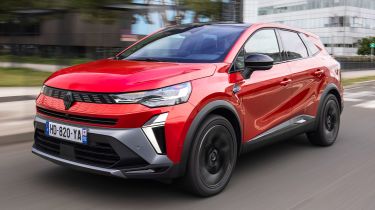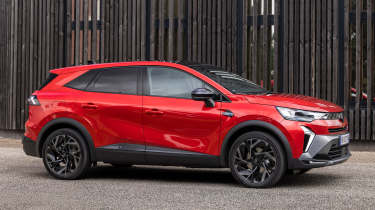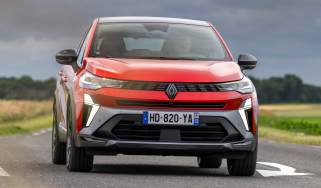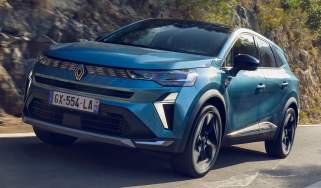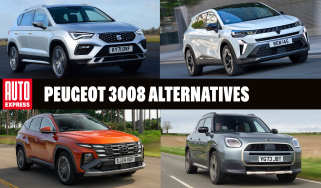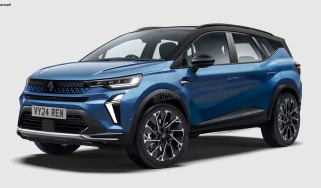Renault Symbioz review
The Renault Symbioz is an attractive offering for family buyers, and should be a very easy car to live with

Our opinion on the Renault Symbioz
The Renault Symbioz is everything you need a family car to be: comfortable, practical, efficient and well equipped. Admittedly, the Symbioz doesn’t have the cavernous interior or boot space offered by some of the mid-size SUVs it competes against, but competitive pricing helps make up for that and the intuitive Google-powered tech never fails to impress.
The changes Renault has made to its handsome family SUV for the 2026 model year aren’t huge, but the Symbioz didn’t really need much updating and they do provide some welcome improvements. Cash-savvy buyers will be drawn to the new, back-to-basics mild-hybrid version, which undercuts key rivals by a sizeable margin, while the revised hybrid set-up will make the Renault an even easier and more relaxing car to live with than it already was.
Key specs | |
| Fuel type | Full hybrid |
| Body style | Mid-size SUV |
| Powertrain | 1.6-litre petrol engine plus electric motor, starter generator and 1.2kWh battery |
| Safety | 4-star Euro NCAP (2024) |
| Warranty | Up to 3 years/60,000 miles |
About the Renault Symbioz
‘Voitures à vivre’ means ‘cars for living’, and it’s a philosophy that connects Renault’s most family-focused models, starting with the Renault 16 from 1965, as well as the original Espace of the eighties and the Scenic of the nineties. The latest branch in this curious family tree is the Symbioz, which was launched last year to try and knock the Nissan Qashqai off its high horse.
While the Symbioz doesn’t pull on the heartstrings the same way as the latest Renault 5, we like its comfortable ride, slick hybrid powertrain, spacious interior, fantastic Google technology and competitive pricing. However the French marque has decided to defy the adage of “if it ain’t broke, don’t fix it”, and introduce brand-new powertrains. You might assume something is seriously wrong with a car for it to be significantly updated within a year of going on sale, but that’s certainly not the case here.
Instead of buyers only being offered Renault’s established but perhaps slightly dated hybrid powertrain, they now have a choice of a simpler ‘mild hybrid 140’ petrol engine, which uses a 138bhp turbocharged 1.3-litre four-cylinder paired with a six-speed manual gearbox, or a brand-new ‘full-hybrid 160’ set-up that features a bigger, more efficient engine and a larger battery for more pure-electric driving.
The introduction of the new entry-level engine has slashed the Symbioz’s starting price down to £27,395. That’s about £2,000 less than it was last year, but more importantly, more than £3,000 cheaper than the most basic Nissan Qashqai or Skoda Karoq. It doesn’t manage to pip the award-winning Hyundai Kona though, prices for which start from £26,735 – but you can’t win them all.
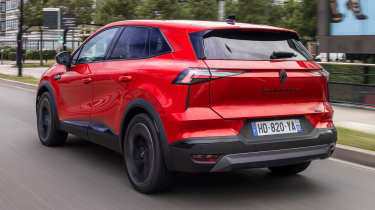
While the new base model, with its attractive price, might increase the Symbioz’s appeal among budget-conscious customers, Renault expects most people will still upgrade to the full-hybrid powertrain, which is available from £29,795. It produces 158bhp from a combination of a new 1.8-litre four-cylinder engine, two electric motors and a 1.4kWh battery.
The mild-hybrid unit is only offered in base Techno specification, but standard equipment still includes a 10.4-inch central touchscreen with Renault’s Google-powered OpenR Link infotainment system (with apps like Google Maps and Google Assistant built-in), plus wireless Apple CarPlay and Android Auto, a 10.25-inch digital driver’s display, a wireless charging pad, reversing camera, keyless entry, LED headlights and adaptive cruise control.
Meanwhile, the hybrid version is available in three trim levels: Techno, Techno Esprit Alpine and Iconic Esprit Alpine. Upgrading to Techno Esprit Alpine specification (which costs £2,000) adds a set of 19-inch wheels and jazzes up the interior with French tricolore stitching, blue gradient dashboard finish and recycled fabric/leather substitute upholstery. Plus, you get heated front seats, a heated steering wheel, a hands-free powered tailgate, blind-spot warning and the Active Driver Assist system, which combines adaptive cruise control and lane centering.
Range-topping Iconic Esprit Alpine models (an extra £4,000 over base Techno) build on that kit list with luxuries including a nine-speaker Harman Kardon premium sound system, 360-degree parking cameras, hands-free parking tech and a ‘SolarBay’ opacifying panoramic sunroof.
Engines, performance & drive
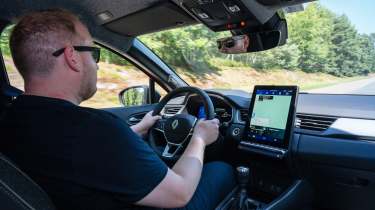
| Pros |
|
| Cons |
|
Think of the Renault Symbioz as a longer version of the Renault Captur compact SUV and you won't go far wrong. The two cars use the same tried-and-tested CMF-B platform – although it’s been stretched slightly for the Symbioz – and they were both powered by Renault’s equally familiar ‘E-Tech hybrid 145’ set-up until the Qashqai rival received its two new powertrains.
Performance, 0-60mph acceleration and top speed
The mild-hybrid version can’t offer any zero-emissions driving like the full-hybrid can, but its four-cylinder engine is smooth, doesn’t sound harsh or strained even when accelerating hard, and becomes quiet when you settle into a cruise. The 0-62mph sprint takes 11.2 seconds, supposedly, but it feels quicker than that in everyday use.
The engine doesn’t need to be worked hard either, especially around town, where we also appreciate the long travel of the clutch pedal, which makes it easy to find the biting point in stop-start traffic. The brake pedal, throttle and steering are relatively light too. This manual gearbox isn’t the most precise, but then again, this isn’t a hot hatch, and it does the job well.
The Symbioz’s hybrid set-up used to feature a 1.6-litre four-cylinder petrol engine, however that’s been replaced by a new 1.8-litre four-cylinder engine – supposedly the most efficient naturally aspirated petrol engine in Europe – assisted by two electric motors. There’s a 48bhp e-motor that can drive the front wheels, plus a 20bhp starter-generator to help fire up the engine.
Those are fed by a 1.4kWh battery – an increase on the old 1.26kWh unit – which, thanks to the extra EV range it allows, helps improve fuel efficiency and cut emissions. Meanwhile, Renault’s highly complex, clutchless automatic transmission has been upgraded to deliver smoother gearchanges and improve responses, plus the new hybrid system uses the e-motor more on the motorway, boosting refinement.
We never thought the Symbioz was painfully slow, but the extra grunt and other tweaks have whittled the car’s official 0-62mph time down to 9.1 seconds. It always starts up and moves away on battery power, plus because the main e-motor produces 205Nm of torque, initial acceleration away from rest is quite punchy.
That was all true before though. The benefits of the upgraded hybrid powertrain only start to show on the open road. This is a car that likes to go at its own pace and, as with other hybrid SUVs, it can be relaxing when you take a gentle approach with the throttle. Suddenly put your foot down when joining the motorway, for instance, and there can be a small delay before the hybrid Symbioz starts accelerating, however, once you’re at cruising speed and let off the throttle, the gearbox shifts up a lot quicker than it ever has in Renault’s other hybrids.
This means the engine quietens down more quickly, too, and simply hums away in the background as you make progress. We also noticed the car was cruising on just the e-motor at times, indicated by a small green ‘EV’ symbol in the corner of the driver’s display.
Town driving, visibility and parking
The Symbioz, particularly the hybrid version, is in its element around town. It can feel like you’re driving an electric car because of how little involvement the petrol engine has, and the ‘B’ mode that gives stronger regenerative braking increases this sensation, because it slows the car whenever you lift off the accelerator and keeps the battery topped up. The transitions between petrol and electric power are almost undetectable, and the blending of the regenerative braking and physical discs feels natural.
The steering has slightly more weight to it and feels slower than in other Renaults we’ve tested, but not so much that it makes manoeuvring the Symbioz around tight car parks or city streets hard work. It helps that the Symbioz is the same width (1,797mm) as the shorter Captur, and has a raised driving position to provide a good view ahead. The Symbioz’s rear windscreen is relatively small however, and the picture quality of the rear-view camera is still rubbish. We wish that Renault had addressed this as part of the updates for 2026.
B-road driving and handling
Escape the city and find yourself on a twistier road, and the Symbioz can hold its own, but it’s certainly not a sharp or particularly fun car to drive. The family crossover does at least stay composed when cornering, and as we mentioned, the blending of regen and physical brakes feels natural.
Motorway driving and long-distance comfort
Head towards the motorway, and the new 1.8-litre engine in the hybrid emits a low rumble that sounds rather distant, and less droning than the old 1.6-litre motor. It settles down more quickly once you’re at cruising speeds too, thanks to the reworked transmission. The only intrusion we detected was some wind noise created by the large side windows. Ride comfort is impressive, even on 19-inch rims, and impacts from potholes were well cushioned.
| Model | Power | 0-62mph | Top speed |
| E-Tech mild hybrid 140 | 138bhp | 11.2s | 105mph |
| E-Tech hybrid 160 | 158bhp | 9.1s | 105mph |
MPG, emissions and running costs
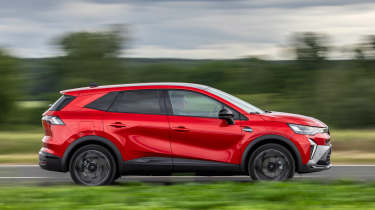
| Pros |
|
| Cons |
|
You don’t have to worry about charging the hybrid version’s 1.4kWh battery, because that’s all taken care of by the starter generator motor and regenerative braking. The Symbioz also features ‘predictive hybrid driving’ technology that uses data on your route, journey time and traffic from Google Maps to optimise use of the two power sources. In addition to the clever tech, the Symbioz weighs less than 1,500kg - which is impressive.
Renault says the mild-hybrid model can average up to 47.9mpg, while the full-hybrid version supposedly can achieve 65.7mpg. We haven’t spent long enough with the new set-ups to properly judge how efficient they are, but we did manage to achieve 61.4mpg when we drove an earlier model with the old hybrid set-up. And based on our experience with that, we wouldn’t be surprised if that figure climbed to nearer 70mpg if you spend more time driving in town, where the electric motor does most of the work.
| Model | MPG | CO2 | Insurance group |
| E-Tech mild hybrid 140 | 47.9mpg | 133g/km | 16 |
| E-Tech full-hybrid 160 | 65.7mpg | 97g/km | 19-20 |
Insurance groups
Depending on which powertrain and trim level you go for, the Renault Symbioz falls into insurance groups 16 to 20. For comparison, the Nissan Qashqai can fall between groups 12 and 30, while the Hyundai Kona sits in groups 16 to 28.
Tax
While there isn’t a plug-in hybrid or electric car version of the Symbioz to attract company car drivers in great numbers, the full-hybrid set-up emits less than 100g/km of CO2 so will receive a lower Benefit-in-Kind (BiK) bill than pure-petrol alternatives.
Depreciation
According to our most recent expert data, the Renault Symbioz is estimated to retain up to 57 per cent of its original value after three years of ownership and 36,000 miles. That’s slightly better than the Hyundai Kona, while the Nissan Qashqai is projected to hold onto 50 per cent on its sticker price at best after the same amount of time.
To get an accurate valuation for a Renault Symbioz, check out our free car valuation tool...
Design, interior & technology
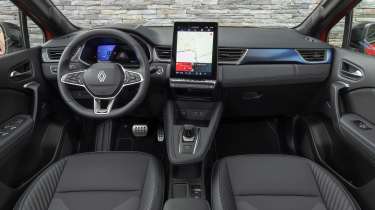
| Pros |
|
| Cons |
|
There’s no need to crack out a magnifying glass to try and spot any design changes, because the Symbioz didn’t receive any cosmetic work when it had the new engines fitted; the interior is practically identical to before too. Which is no bad thing.
The Symbioz was designed at exactly the same time as the facelifted Captur, in the knowledge that the purposeful, chunky front end look would be worn by both cars. The pair embrace Renault’s newest design language that was first seen on the all-electric Scenic E-Tech. Signature elements include the sharp vertical LED strakes, complex grille pattern, sculpted bonnet and generally very angular styling.
It’s not all copy and paste, however. The Symbioz gets a unique, more heavily stylised rear end than the Captur, plus 3D ‘ice cube’ tail-lights and a roof spoiler. The 18 and 19-inch alloy wheel designs are exclusive to the Symbioz, and buyers have seven paint colours to choose from.
Interior and dashboard design
It’s a similar story inside, because the Symbioz uses the same functional interior design as the Captur – and that will make this an easy car to live with. For instance, below the touchscreen is a bank of physical toggle switches for the climate controls, plus there are buttons on the steering wheel. We also like that in the hybrid version the wireless charging pad, which can accommodate even the largest smartphones, is located out of sight under the housing for the gear selector so you shouldn’t get distracted by any incoming notifications.
Materials and build quality
Material and build quality are both strong, with a decent amount of soft-touch materials dotted around. All but the base model receive the Esprit Alpine treatment, which adds a few special touches to the cabin including upholstery made from 26 per cent recycled fabric, and a dashboard panel with a blue gradient effect and textured fabric.
Reserved exclusively for top-of-the-range models is the single-piece Solarbay glass roof. This makes the cabin feel more airy because, rather than using a mechanical blind, the opacity of the glass itself can be changed from fully transparent to fully opaque, or even half-and-half, at the push of a button.
Sat-nav, stereo and infotainment
Every Renault Symbioz features a 10.25-inch customisable digital driver’s display and 10.4-inch touchscreen that are both sharp and responsive. They’re running the very latest version of Renault’s simply excellent OpenR Link infotainment system, which is based on Google’s Android Automotive operating system.
That means the menus are easy to navigate because they’re laid out like those on a smartphone, and services such as Google Maps and Google Assistant come built-in. There are 50 additional apps available through the Google Play store too, such as Waze and Spotify, but wireless Apple CarPlay and Android Auto also come as standard if you prefer.
Boot space, comfort & practicality
| Pros |
|
| Cons |
|
When it comes to practicality, the Symbioz isn’t on the same level as the Kia Sportage or a Hyundai Tucson, but does give the Nissan Qashqai a run for its money. One trick up its sleeve is a sliding rear bench that comes as standard, and can be pushed forward by up to 16cm.
It’s done by pulling a handle underneath the middle seat, and the process is quick and simple but does require a bit of gusto. We don’t expect owners will be moving it around all the time, but on the day you’re loading up the car for a family holiday and need just a little space for everyone’s luggage, you’ll appreciate having it.
Renault also says there’s about 25 litres of storage space dotted around the cabin. The door bins up front are a decent size, and those in the back are good for a regular-sized water bottle, plus there are nets on the backs of the seats. Rear passengers also get a pair of USB-C charging ports.
Dimensions | |
| Length | 4,413mm |
| Width | 1,797mm |
| Height | 1,575mm |
| Number of seats | 5 |
| Boot space | 492-1,582 litres |
Dimensions and size
The Renault Symbioz measures 4,413mm long and 1,797mm wide, with a wheelbase of 2,638mm – in every case within millimetres of the Qashqai’s dimensions. The two rivals are also exactly the same height. Compared with another competitor, the Hyundai Kona, the Symbioz is 63mm longer and has a longer wheelbase, but is 28mm narrower and 10mm shorter.
Driving position, seats & space in the front

The driving position in the Symbioz is naturally quite lofty, as you’d expect for a family SUV. Paired with a large windscreen and stubby bonnet, this provides a good view of the road ahead, plus it helps if you need to navigate tight car parks and traffic in town. With plenty of adjustment in both the driver’s seat and steering wheel too, you won’t struggle to get comfortable.
Seats & space in the back
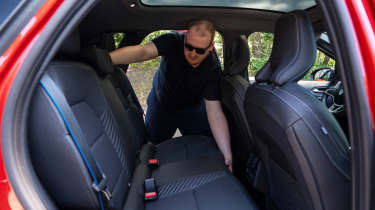
Even with six-foot-tall adults sitting up front, there’s plenty of legroom for similarly tall rear passengers, who also get headroom to spare, and space under the front seats for their feet too. However, the cabin isn’t very wide and the large hump in the floor eats into foot space, so it would be a tight squeeze getting three adults in the back.
If it’s just young children you’ve got to ferry around, the wide rear door opening will help when installing child seats and there are two sets of Isofix mounting points on the rear bench.
Boot space
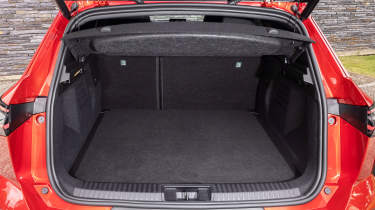
The Symbioz offers 492 litres of boot space as standard – just shy of the up to 504-litre capacity in the Nissan Qashqai – but that figure expands to 624 litres with the rear seats slid all the way forwards. A height-adjustable boot floor is also standard fit, and the rear bench folds down in a 60:40 split, giving you 1,582 litres of space to play with.
Towing
The Symbioz has a maximum towing capacity of 1,200kg, if you get the base mild-hybrid 140 engine. Opt for the full-hybrid 160 version and that shrinks to 1,000kg, however that’s still more than the 750kg the car was previously rated to haul.
Safety & reliability
| Pros |
|
| Cons |
|
Up to 24 advanced driver-assistance systems are available on the Renault Symbioz, including ‘Active Driver Assist’, which offers Level 2 autonomous driving capabilities by combining adaptive cruise control with the stop and go function, lane centering and traffic-sign recognition. The car can even move over slightly to one side of a lane to give more room for approaching motorcycles.
Rear automatic emergency braking, blind-spot warning, lane-departure warning and driver attention alert are among the other safety systems on offer. The only features reserved for the very top-spec models are a 360-degree parking camera se-tup and hands-free parking.
But Renault knows that some drivers don’t want all these features active all the time. So instead of forcing them to dig through the touchscreen every time they switch the car on, the Symbioz features the brand’s simple but brilliant ‘My Safety Perso’ button on the dashboard that, with just two quick presses, activates a personalised mode for the ADAS suite that takes care of various binging and bonging. Drivers can decide if they want a function on, to what level, and if they want audible alerts. It’s a simple solution that makes life so much easier, and frankly we wouldn’t be surprised if other companies follow the idea.
The Symbioz also gets a ‘Safety Coach’ that gives you advice on how to drive more safely in real-time and a score out of 100. It’ll even tell you to maintain more distance between the car in front, or to be more attentive, if necessary. But during our test drive we never received any nannying from the system.
| Key standard safety features |
|
| Euro NCAP safety ratings |
|
Buying and owning
Our best buy: Renault Symbioz Techno Esprit Alpine E-Tech 160
If it were our money, we’d go for the Symbioz with the full-hybrid 160 powertrain, which offers a more relaxing driving experience with pure-electric driving abilities; it also therefore uses less fuel, making it cheaper to run than the simpler mild-hybrid version. In terms of the trim level, mid-range Techno Esprit Alpine spec would be our choice because, for a small increase in price, it gets a nicer, sportier interior finish and even more kit than the already generously equipped base model.
Auto Express Find A Car can help you find the best deals out there on a new Renault Symbioz or top prices on used Renault Symbioz models...
Renault Symbioz alternatives
The Renault Symbioz’s biggest rival is the Nissan Qashqai – the archetypal family SUV. But while the Symbioz offers similar levels of practicality, it has been priced in a way that undercuts its foe by a significant margin. Other alternatives to the Renault Symbioz include big-sellers like the Skoda Karoq and Kia Sportage. Based on its size and price, the Symbioz also has to contend with some of the more practical small SUVs out there, particularly the Kia Niro and, our 2023 Car of the Year, the Hyundai Kona.
Great leasing deals on a Renault Symbioz and alternatives
Renault Symbioz
Nissan Qashqai
Skoda Karoq
Renault Symbioz pictures
Frequently Asked Questions
The Renault Symbioz is a good family-focused SUV that offers appealing value for money, thanks to strong practicality and the slick E-Tech hybrid powertrain that comes as standard.

